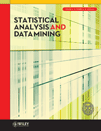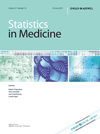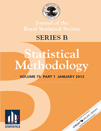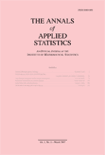
BIOMETRICS
Scope & Guideline
Empowering Researchers with Rigorous Peer-Reviewed Findings
Introduction
Aims and Scopes
- Causal Inference:
Research in this area encompasses the development of methods to draw causal conclusions from observational and experimental data, including techniques like propensity score matching and instrumental variable analysis. - Survival Analysis:
This includes statistical methods for analyzing time-to-event data, particularly in clinical trials and epidemiological studies, with a focus on developing robust models that account for censoring and time-varying covariates. - Bayesian Methods:
The journal publishes works that apply Bayesian statistical methods to a wide range of problems, including hierarchical modeling, Bayesian nonparametrics, and empirical Bayes approaches. - High-Dimensional Data Analysis:
This area focuses on the development of statistical techniques to handle high-dimensional datasets, particularly in genomics and neuroimaging, addressing challenges like sparsity and multicollinearity. - Statistical Modeling and Inference:
The journal emphasizes the creation of new statistical models and inference techniques that enhance the understanding of complex biological processes and improve decision-making in healthcare. - Machine Learning Integration:
Research that integrates machine learning techniques with traditional statistical methods is increasingly featured, particularly for predictive modeling and causal inference in large datasets.
Trending and Emerging
- Causal Mediation Analysis:
This theme focuses on understanding the pathways through which treatments affect outcomes, utilizing advanced statistical techniques to elucidate causal relationships in complex datasets. - Machine Learning and AI in Biostatistics:
The integration of machine learning techniques into biostatistical research is on the rise, with publications exploring applications in predictive modeling and feature selection for high-dimensional data. - Personalized Medicine and Individualized Treatment Effect Estimation:
Emerging research emphasizes the development of statistical methods that enable personalized treatment strategies, particularly in clinical research, tailoring interventions based on individual characteristics. - Data Integration Techniques:
Increasing emphasis is placed on methods for integrating diverse data sources, such as electronic health records and genetic data, to enhance the robustness of statistical inferences. - Spatial Statistics and Epidemiology:
There is a growing focus on spatial statistical methods for analyzing disease spread and environmental health data, reflecting the importance of spatial considerations in public health research. - Robustness and Sensitivity Analysis:
Research that investigates the robustness of statistical methods and the sensitivity of conclusions to assumptions is gaining prominence, highlighting the need for transparency and rigor in statistical practice.
Declining or Waning
- Traditional Frequentist Methods:
There has been a noticeable decrease in the publication of studies relying solely on traditional frequentist approaches, as the field increasingly embraces Bayesian and machine learning methods. - Basic Descriptive Statistics:
Papers focusing primarily on basic descriptive statistics or simple hypothesis testing have become less common, as researchers seek to apply more sophisticated analytical techniques. - Non-Parametric Methods:
Although still relevant, the frequency of publications centered on traditional non-parametric methods appears to be waning, possibly due to the rise of more flexible parametric and semi-parametric approaches that accommodate complex data structures. - Single-variable Regression Models:
Research focusing exclusively on single-variable regression models is declining as the complexity of data and the need for multivariable approaches grow. - Standard Meta-Analysis Techniques:
While meta-analysis remains important, the basic methodologies have become less prominent as new, more nuanced approaches to synthesizing evidence from multiple studies gain traction.
Similar Journals

Statistical Analysis and Data Mining
Driving Progress in Statistical Techniques and ApplicationsStatistical Analysis and Data Mining is a leading journal published by WILEY, dedicated to exploring the latest advancements in statistical methods and data mining techniques. With an ISSN of 1932-1864 and an E-ISSN of 1932-1872, this journal serves as a significant platform for researchers and professionals in statistical analysis, computer science applications, and information systems. Covering a wide range of topics from innovative analytical methodologies to emerging data mining algorithms, the journal aims to disseminate high-quality research that contributes to the evolving landscape of data science. Ranked in the Q2 category for the fields of Analysis, Computer Science Applications, and Information Systems in 2023, it emphasizes its relevance and impact within academia. While it offers limited Open Access options, the insights shared in this publication are integral for those wishing to stay ahead in fast-paced research and data-driven industries. Since its inception in 2008 and continuing through 2024, Statistical Analysis and Data Mining invites submissions that reflect rigorous empirical research coupled with practical implications, making it a vital resource for the academic community.

METRIKA
Navigating Complexity with Statistical Precision.METRIKA is a distinguished journal published by Springer Heidelberg, specializing in the field of Statistics and Probability. Since its inception in 1958, this journal has been pivotal in advancing the study and application of statistical methods, theory, and research. With an impressive academic legacy extending to 2024, METRIKA holds a Q2 category ranking in both Statistics and Probability and Statistics, Probability and Uncertainty, as of 2023, which underscores its significance within the scholarly community. Researchers and professionals will find that METRIKA not only emphasizes the recent developments and applications in the field but also aims to foster an interdisciplinary dialogue among statisticians and data scientists. Its contributions are invaluable for those seeking to navigate the complexities of statistical methodologies. Although the journal primarily operates under a traditional access model, its commitment to excellence and relevance in statistical discourse ensures that it remains an essential resource for academics, practitioners, and students alike.

STATISTICS IN MEDICINE
Pioneering statistical methods for impactful medical insights.Statistics in Medicine, published by Wiley, is a prestigious journal dedicated to the advancement of statistical methods and their application in biomedical research. Established in 1982, this journal has become a cornerstone in the fields of Epidemiology and Statistics and Probability, demonstrating its importance by consistently achieving a Q1 ranking in the 2023 category quartiles. With an impressive ISSN of 0277-6715 and an E-ISSN of 1097-0258, it serves as a vital platform for disseminating high-quality research that enhances evidence-based medicine. Although the journal does not currently offer open access, it remains highly regarded, holding a Scopus rank of #66 in Mathematics and #80 in Medicine, indicating its significant impact on the academic community. By publishing cutting-edge research, Statistics in Medicine aims to bridge the gap between statistical theory and practical application in health domains, fostering a rigorous dialogue among researchers, clinicians, and statisticians alike.

Communications for Statistical Applications and Methods
Fostering Collaboration in the World of Statistical SciencesCommunications for Statistical Applications and Methods is a vital academic journal dedicated to advancing the field of statistics, with a particular focus on practical applications and methodologies. Published by the Korean Statistical Society, this journal has become a significant resource for researchers, practitioners, and students engaged in statistical sciences and its diverse applications in various fields including finance and modeling. Operating without an Open Access format, the journal is accessible through institutional subscriptions, allowing a broad audience to benefit from its insights. The journal covers works from its inception in 2017 to 2024, and although it currently ranks in the Q4 and Q3 quartiles across various mathematical and statistical categories, its commitment to quality research makes it a noteworthy platform for emerging trends and innovations. The journal not only serves to disseminate knowledge but also fosters collaboration among statisticians, ensuring that crucial advancements in statistical applications are communicated effectively.

STATISTICA SINICA
Where Statistical Rigor Meets Innovative ThoughtSTATISTICA SINICA, published by the esteemed STATISTICA SINICA organization, stands as a premier journal in the fields of Statistics and Probability, boasting a significant impact within the academic community. With an ISSN of 1017-0405 and E-ISSN of 1996-8507, this journal has evolved from its inception in 1996, continuing to publish cutting-edge research through 2024. As recognized by its recent categorization in Q1 quartiles in both Statistics and Probability and Statistics, Probability and Uncertainty for 2023, it ranks among the top journals in its discipline, meriting attention from researchers and practitioners alike. Despite lacking open access options, it delivers rigorous, peer-reviewed articles that contribute to the advancement of statistical science. With its base in Taiwan, and a dedicated editorial team located at the Institute of Statistical Science, Academia Sinica, Taipei, STATISTICA SINICA continues to be a vital resource for statisticians, data scientists, and related professionals seeking innovative methodologies and insights within this dynamic field.

Statistics and Applications
Bridging Theory and Practice in Statistical Science.Statistics and Applications is an esteemed academic journal dedicated to disseminating innovative research findings and advancements within the field of statistics and its diverse applications. Published by SOC STATISTICS COMPUTER & APPLICATIONS, this journal operates under an open access model, ensuring that critical knowledge and research are freely available to researchers, professionals, and students worldwide. With an ISSN of 2454-7395, it serves as a key platform for scholars to share their insights on statistical methodologies, computational techniques, and novel applications across various disciplines. Although the journal’s impact factor is not currently listed, its commitment to rigorous peer review and high-quality publications positions it as a valuable resource in the continuously evolving domain of statistics. By fostering collaboration among researchers and encouraging the sharing of knowledge, Statistics and Applications contributes significantly to the advancement of statistical science and its applications in real-world problems.

JOURNAL OF THE ROYAL STATISTICAL SOCIETY SERIES B-STATISTICAL METHODOLOGY
Bridging Theory and Practice in StatisticsJOURNAL OF THE ROYAL STATISTICAL SOCIETY SERIES B-STATISTICAL METHODOLOGY, published by OXFORD UNIVERSITY PRESS, is a leading academic journal dedicated to advancing the field of statistical methodology. With a distinguished Q1 ranking in both Statistics and Probability and Statistics, Probability and Uncertainty as of 2023, this journal stands at the forefront of statistical research, serving as a vital resource for researchers, professionals, and students alike. The journal has been committed to fostering innovative statistical techniques and methodologies since its inception in 1997, covering a wide scope of topics that push the boundaries of statistical applications in various disciplines. Based in the United Kingdom, the journal maintains its reputation through rigorous peer-review practices and high-quality content, making it an indispensable platform for those looking to disseminate their findings and engage with current trends in statistical science. Although the journal does not offer open access, the impact and scholarly significance of its articles remain profoundly influential in shaping contemporary statistical discourse.

Annals of Applied Statistics
Unveiling Innovations in Statistical ResearchThe Annals of Applied Statistics, published by the Institute of Mathematical Statistics (IMS), is a leading academic journal that serves as a crucial repository for groundbreaking research in the fields of statistics and probability applications. Since its inception in 2008 and continuing through 2024, this journal has established itself as an influential platform with a notable reputation, boasting a prestigious Q1 classification in 2023 across critical categories such as Modeling and Simulation and Statistics, Probability, and Uncertainty. With its rigorous peer-review process and significant Scopus rankings—including a position of #78 in Statistics and Probability—Annals of Applied Statistics aims to foster innovative statistical methods and their applications in a variety of disciplines. Researchers, professionals, and students interested in the latest advancements in analytical methods will find this journal essential for navigating the evolving landscape of applied statistics. The journal does not offer open access options, ensuring that published content reflects the highest academic standards.

Survey Methodology
Exploring innovative methods in survey research.Survey Methodology, published by STATISTICS CANADA, is a prominent academic journal dedicated to the exploration and advancement of survey methods across various domains. First established in 1987, this journal has become a significant resource for researchers, professionals, and students interested in methodological developments in data collection and statistical analysis. With a 2023 Q2 ranking in Modeling and Simulation and a Q3 ranking in Statistics and Probability, Survey Methodology provides a vital platform for disseminating innovative research and practical applications related to survey techniques, contributing to the field's robust discourse. Although it operates on a subscription basis, the journal's archives from its inception to present are invaluable for those seeking to deepen their understanding of contemporary survey practices. By bridging theory and application, Survey Methodology supports the continuous improvement of survey research, thus playing an essential role in shaping data-driven decision-making in both academic and applied settings.

JOURNAL OF BUSINESS & ECONOMIC STATISTICS
Advancing Insights in Business and EconomicsJOURNAL OF BUSINESS & ECONOMIC STATISTICS is a premier academic journal published by Taylor & Francis Inc, dedicated to disseminating high-quality research in the fields of business, economics, and statistics. With an impressive impact in the academic community, the journal maintains a distinguished Q1 ranking across various categories including Economics and Econometrics, Social Sciences (miscellaneous), and Statistics and Probability, showcasing its relevance and influence in contemporary research. Since its inception in 1983, the journal has served as a vital resource for researchers, professionals, and students seeking insights into quantitative methodologies and their application in the economic domain. While the journal is not currently open access, its rigorous peer-review process ensures that published articles are of the highest scholarly standards. Researchers and practitioners alike will find a rich repository of empirical and theoretical studies that foster knowledge advancement in the intersecting realms of business, economics, and statistical analysis.